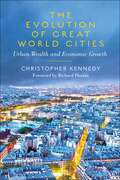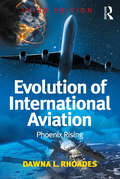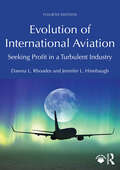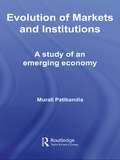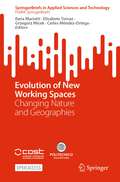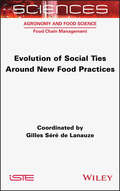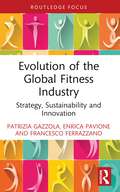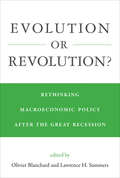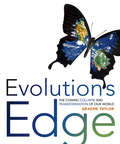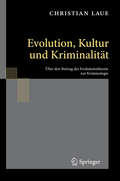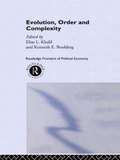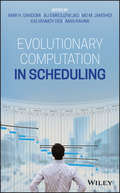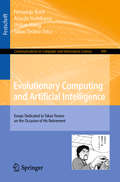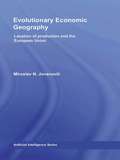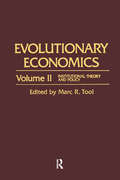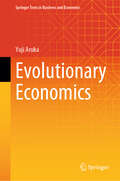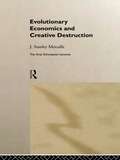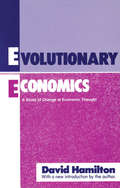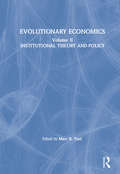- Table View
- List View
Evolution of Great world Cities
by Christopher KennedySome cities seem destined to become major financial capitals, yet never do--Seville, for instance, was the centre of Spain's opulent New World Empire, but failed to become a financial metropolis. Others, like former colonial backwater Hong Kong, defy the odds by growing into major trading centres. What are the key factors distinguishing those cities that become wealthy from those that don't? Christopher Kennedy illuminates how geography, technology, and especially the infrastructure of urban economies allow cities to develop and thrive.The Evolution of Great World Cities unfolds through the tales of several urban centres--including Venice, Amsterdam, London, and New York City--at key junctures in their histories. Kennedy weaves together significant insights from urbanists such as Jane Jacobs and economists such as John Maynard Keynes, drawing striking parallels between the functioning of ecosystems and of wealthy capitals. The Evolution of Great World Cities offers an accessible introduction to urban economies that 'will change the way you think about cities.'
Evolution of International Aviation: Phoenix Rising
by Dawna L. RhoadesThe purpose of this book is twofold. First, it lays out the forces that shaped the international aviation industry and that changed all the rules in the drive for liberalization. Second, it looks at the many interesting and difficult choices ahead that the airline industry in general and the international aviation industry in particular face. These choices include many dichotomies: pulling back from the trend toward liberalization or embracing the liberalization trend, merging in search of profitability or fragmenting the industry in search of economies. These possible futures are explored including the pros and cons of each future from a national, consumer, employer, and employee perspective. As with the previous two editions, Evolution of International Aviation reviews the historical development of the international aviation system. From this foundation it then provides an updated and expanded account of the current state of the aviation and aerospace industry including profitability, consolidation, and merger activity. New to this edition, the book broadens the coverage of the industry segments - airlines, air cargo, and manufacturing - to include the emerging commercial space sector. It also emphasizes the relationship between aviation and the political process, exploring the sustainability of this mode of transportation in a world of climate change, high oil prices, and political instability. Because this book is intended for both the interested amateur and the more serious student, references are provided in the text and at the end of each chapter to allow for further in-depth study. The third edition also adds to each chapter a set of learning objectives and a concluding series of questions for discussion.
Evolution of International Aviation: Seeking Profit in a Turbulent Industry
by Dawna L. Rhoades Jennifer L. HinebaughThe purpose of this book is twofold. First, it lays out the forces that shaped the international aviation industry and that changed all the rules in the drive for liberalization. Second, it looks at the many interesting and difficult choices ahead that the airline industry in general and the international aviation industry in particular face. These choices include many dichotomies: pulling back from the trend toward liberalization or embracing the liberalization trend, merging in search of profitability or fragmenting the industry in search of economies. These possible futures are explored, including the pros and cons of each future from a national, consumer, employer, and employee perspective. Evolution of International Aviation has been substantially revised to place the triple crises – 9/11, the 2008 Global Financial Crisis, and the COVID-19 pandemic – into context with the declared new Golden Age of 2018 (A4A), Brexit, renewed government aid around the globe, and the Ukraine conflict. It includes a new chapter on safety and security that will start with processes and technology introduced after 9/11 (such as the 24-hour rule, known shippers, and Global Entry programs) and end with recent biometrics and digital identity. As with the previous three editions, this fourth edition of Evolution of International Aviation reviews the historical development of the international aviation system. From this foundation it then provides an updated and expanded account of the current state of the aviation and aerospace industry, including profitability, consolidation, and merger activity. The book includes coverage of the industry segments – airlines, air cargo, and manufacturing – to include the emerging commercial space sector. It also emphasizes the relationship between aviation and the political process, exploring the sustainability of this mode of transportation in a world of climate change, high oil prices, and political instability. Because this book is intended for both the interested amateur and the more serious student, references are provided in the text and at the end of each chapter to allow for further in-depth study.
Evolution of Management in a Post-Pandemic World: The Chameleon Paradigm (Routledge Studies in Management, Organizations and Society)
by Agnieszka RzepkaDeveloped by Agnieszka Rzepka, the Chameleon Paradigm is the culmination of twenty years of global research which identifies critical factors essential for organizational success in a volatile marketplace. The Paradigm provides a roadmap for organizations, addressing key elements necessary for thriving in a 5.0 reality. With market trends pushing companies towards sustainable, human-centric industries, the book argues that organizations should function as living organisms, where one failing component can disrupt the whole system.Rzepka’s framework combines nine interdependent elements—leadership, innovation, relationships, culture, agility, capital, competence, knowledge, and strategy. The Chameleon Paradigm emphasizes the evolution in management models, shifting societal consciousness, and new workforce dynamics. The book analyzes companies that successfully navigated the pandemic’s challenges, offering a model for resilient and innovative organizations. The book highlights discrepancies between recommended and actual practices in contemporary business and draws a conclusion that effective 21st-century leadership requires agility, proactive behavior, and a growth-focused approach. The accompanying verification tool allows organizations to assess their alignment with the paradigm and identify areas for improvement.The monograph offers key management models and practical recommendations that can be implemented by managers and SMEs and will be of interest to researchers, academics, professionals, and students in the fields of organizational studies, leadership, management, and innovation. By applying Rzepka’s model, managers can design, build, and operate innovative and resilient local and global organizations.
Evolution of Markets and Institutions: A Study of an Emerging Economy (Routledge Studies in Development Economics)
by Murali PatibandlaThe new institutional economics has been one of the most influential schools of thought to emerge in the past quarter century. Taking its roots in the transaction cost theory of the firm as an economic organization rather than purely a production function, it has been developed further by scholars such as Oliver Williamson, Douglas North and their followers, leading to the rich and growing field of the new institutional economics. This branch of economics stresses the importance of institutions in the functioning of free markets, which include elaborately defined and effectively enforced property rights in the presence of transaction costs, large corporate organizations with agency and hierarchical controls, formal contracts, bankruptcy laws, and regulatory institutions. In this timely volume, Murali Patibandla applies some of the precepts of the new institutional economics to India - one of the world's most promising economies.
Evolution of New Working Spaces: Changing Nature and Geographies (SpringerBriefs in Applied Sciences and Technology)
by Ilaria Mariotti Grzegorz Micek Elisabete Tomaz Carles Méndez-OrtegaThis open access book provides multidisciplinary perspectives on the changing dynamics of new working spaces, with insights from various European countries and observing critical theoretical approaches. Divided into two main parts, the first part focuses on the different typologies of new working spaces, identifying the changing nature of these spaces and associated concepts, taxonomies, and specific approaches to this phenomenon. The second part analyzes the location of new working spaces, examining its recent evolution and identifying new factors and geographies, offering an additional empirical analysis of different European realities. The research included in this book contributes to the current discussion of new forms and geographies of work and their impact on the territories and related policies.
Evolution of Social Ties around New Food Practices
by Gilles Séré de LanauzeWe live in a world of major disruption, where the individual and the collective stand in opposition against the backdrop of globalization, digital revolution, community development, growing concerns around health and the planet, and now an unprecedented global health crisis.This book explores how these phenomena influence the social ties that surround food and the way we eat together. Extensive research is presented on institutional recommendations concerning eating together, the role of online communities in supporting weight loss, the perceived consequences of diets, the social phenomena involved in vegetarianism, market segmentation in the case of ritual and religious practices, and the rising tendency to "buy local" and to value local identity. As the Covid-19 crisis adds to the complexity of these issues, its impact is also taken into account.For both interested readers and the many players involved in the agri-food industry, these reflections shed light on the current developments in "eating together".
Evolution of Time-Driven Activity-Based Costing: Introduction
by Robert S. Kaplan Steven R. AndersonThis chapter introduces and defines Time-Driven Activity-Based Costing (TDABC), providing a brief history of its development, and illustrating its innovative advantages over the traditional Activity-Based Costing (ABC) system.
Evolution of the Automobile Industry: A Capability-Architecture-Performance Approach (Elements in Business Strategy)
by Takahiro FujimotoThis Element applies capability-architecture-performance (CAP) approach of industrial analysis to the evolution of the automobile industry and the strategies of its leading manufacturing firms between the late 19th century and the early 21st century. It regards a manufacturing site ('genba,' such as factory, development facility, etc.) and a product (and other economic artifacts, such as processes) as the two basic units of analysis. Both an industry and a firm can be seen as a collection of sites, as well as a collection of products. The CAP framework predicts that dynamic fits between the sites' organizational capabilities and the product/process architectures lead to sustainable competitive performance. Such key concepts as flows of value-carrying design information, productive/market/profit performance, design-based comparative advantage, integral/modular architectures, multi-skilling, coordinative capability-building, evolutionary capabilities, industry lifecycle, and architectural evolution are discussed in a systematic and dynamic way.
Evolution of the Drone Industry
by Emilie Billaud Andy Wu Rory McDonald Ryan BayerThis note focuses on the development of the drone industry in recent years and provides insights on the drone technology, regulations, applications, market size, top players, and ecosystem. This note was written in conjunction with the case study "Parrot: Navigating the Nascent Drone Industry" (HBS No. 619-085).
Evolution of the Exchange Industry
by Manuela GeranioThis book describes the dramatic changes that have occurred in the exchange industry during the past two decades. The strategies adopted by major world exchanges during this period are explained and the roles of multilateral trading systems and over-the-counter (OTC) players are clearly described, highlighting their economics and their interconnections with traditional exchanges. Up-to-date, comprehensive comparisons are made of the performances of the main exchanges, and important governance issues are considered. In addition, threats and opportunities for major types of trading venue, deriving either from new regulatory approaches or from the surge in new markets, are presented and discussed with a view to forecasting future developments in the secondary market industry. The background to the book is the strong erosion in traditional profit drivers for exchanges produced by the progress in communications and trading technology. In many countries, regulation has reduced barriers to entry in the equity field, facilitating a surge in new players and a shift of liquidity toward alternative trading platforms and dark pools.
Evolution of the Global Fitness Industry: Strategy, Sustainability and Innovation (ISSN)
by Patrizia Gazzola Enrica Pavione Francesco FerrazzanoThe pandemic has taught us all how important it can be to look after our physical and mental health, and how worthwhile it is to invest in taking care of ourselves. This short book illustrates the main trends that are modifying the fitness industry worldwide and highlights contemporary relevance to strategic change. It outlines what is currently happening within the promising fitness market and analyses the major emerging trends and the scientific data, referring to startups that could become very interesting market players in the years to come. Sustainability and technology will be the subject of in-depth analysis, as they represent the main drivers that will guide the sector in the future. The book also considers the most important aspect of sustainability related to the fitness industry and wellness more generally: the Silver Economy. The analysis is supported by an extensive database involving the 100 leading companies in the sector worldwide. The novelty of this research is to provide a document analysing the typical characteristics of this market, consumption dynamics, consumer triggers, and underlying the socio-economic scenario. The treatment of key themes such as fitness-tech startups, sport strategic management and above all innovation and sustainability make the book unique and appealing to researchers, academics, students, and practitioners.
Evolution of the Market Process: Austrian and Swedish Economics (Routledge Studies In The History Of Economics #Vol. 70)
by Michel Bellet Sandye Gloria-Palermo Abdallah ZouacheThis impressive volume centres on the relationship between Austrian and Swedish economics. Exploring themes such as capital theory, expectations, policy, market theory and the history of economic thought, this book makes for an interesting read. It will appeal across a wide range of disciplines within economics as well as the philosophy of social s
Evolution or Revolution?: Rethinking Macroeconomic Policy after the Great Recession (The\mit Press Ser.)
by Olivier Blanchard Lawrence SummersLeading economists discuss post–financial crisis policy dilemmas, including the dangers of complacency in a period of relative stability.The Great Depression led to the Keynesian revolution and dramatic shifts in macroeconomic theory and macroeconomic policy. Similarly, the stagflation of the 1970s led to the adoption of the natural rate hypothesis and to a major reassessment of the role of macroeconomic policy. Should the financial crisis and the Great Recession lead to yet another major reassessment, to another intellectual revolution? Will it? If so, what form should it, or will it, take? These are the questions taken up in this book, in a series of contributions by policymakers and academics. The contributors discuss the complex role of the financial sector, the relative roles of monetary and fiscal policy, the limits of monetary policy to address financial stability, the need for fiscal policy to play a more active role in stabilization, and the relative roles of financial regulation and macroprudential tools. The general message is a warning against going back to precrisis ways—to narrow inflation targeting, little use of fiscal policy for stabilization, and insufficient financial regulation.ContributorsDavid Aikman, Alan J. Auerbach, Ben S. Bernanke, Olivier Blanchard, Lael Brainard, Markus K. Brunnermeier, Marco Buti, Benoît Cœuré, Mario Draghi, Barry Eichengreen, Jason Furman, Gita Gopinath, Pierre-Olivier Gourinchas, Andrew G. Haldane, Philipp Hildebrand, Marc Hinterschweiger, Sujit Kapadia, Nellie Liang, Adam S. Posen, Raghuram Rajan, Valerie Ramey, Carmen Reinhart, Dani Rodrik, Robert E. Rubin, Jay C. Shambaugh, Tharman Shanmugaratnam, Jeremy C. Stein, Lawrence H. Summers
Evolution's Edge: The Coming Collapse and Transformation of Our World
by Graeme TaylorThe coordinator of BEST Futures, a project researching sustainable solutions to global problems, advocates the need for a new evolutionary direction to address growing crises due to diminishing resources. In support of this transformation, he discusses the basis of a sustainable society; progress indicators that take into account emotional, intellectual, and spiritual needs; and tools for constructive change (e. g. , The Earth Charter, 2000). Color illustrations by Fereshteh M. Sadeghi enhance the text. Distributed by Consortium Books Sales and Distribution. Annotation ©2009 Book News, Inc. , Portland, OR (booknews. com)
Evolution, Kultur und Kriminalität
by Christian LaueDie Evolutionsbiologie gilt einerseits als Königsdisziplin der Biologie, andererseits wird sie nach den erschreckenden Erfahrungen mit der Kriminalbiologie vor allem mit Eugenik, Sozialdarwinismus und Rassismus in Verbindung gebracht. Tatsächlich bietet die Evolutionstheorie viele Antworten auf kriminologisch interessante Fragen. Der Autor überbrückt den Graben zwischen sozialwissenschaftlich orientierter Kriminologie und den Biowissenschaften und untersucht, inwieweit neue Erkenntnisse aus der Evolutionsbiologie die Kriminologie bereichern können.
Evolution, Order and Complexity (Routledge Frontiers of Political Economy)
by Elias Khalil Kenneth BouldingEvolution, Order and Complexity reflects topical interest in the relationship between the social and natural worlds. It represents the cutting edge of current thinking which challenges the natural/social dichotomy thesis by showing how the application of ideas which derive from biology can be applied and offer insight into the social realm. This is done by introducing the general system theory to the methodological debate on the relation of human and natural sciences.
Evolutionary Computation in Scheduling
by Kalyanmoy Deb Ali Emrouznejad Amir H. Gandomi Mo M. Jamshidi Iman RahimiPresents current developments in the field of evolutionary scheduling and demonstrates the applicability of evolutionary computational techniques to solving scheduling problems This book provides insight into the use of evolutionary computations (EC) in real-world scheduling, showing readers how to choose a specific evolutionary computation and how to validate the results using metrics and statistics. It offers a spectrum of real-world optimization problems, including applications of EC in industry and service organizations such as healthcare scheduling, aircraft industry, school timetabling, manufacturing systems, and transportation scheduling in the supply chain. It also features problems with different degrees of complexity, practical requirements, user constraints, and MOEC solution approaches. Evolutionary Computation in Scheduling starts with a chapter on scientometric analysis to analyze scientific literature in evolutionary computation in scheduling. It then examines the role and impacts of ant colony optimization (ACO) in job shop scheduling problems, before presenting the application of the ACO algorithm in healthcare scheduling. Other chapters explore task scheduling in heterogeneous computing systems and truck scheduling using swarm intelligence, application of sub-population scheduling algorithm in multi-population evolutionary dynamic optimization, task scheduling in cloud environments, scheduling of robotic disassembly in remanufacturing using the bees algorithm, and more. This book: Provides a representative sampling of real-world problems currently being tackled by practitioners Examines a variety of single-, multi-, and many-objective problems that have been solved using evolutionary computations, including evolutionary algorithms and swarm intelligence Consists of four main parts: Introduction to Scheduling Problems, Computational Issues in Scheduling Problems, Evolutionary Computation, and Evolutionary Computations for Scheduling Problems Evolutionary Computation in Scheduling is ideal for engineers in industries, research scholars, advanced undergraduates and graduate students, and faculty teaching and conducting research in Operations Research and Industrial Engineering.
Evolutionary Computing and Artificial Intelligence: Essays Dedicated to Takao Terano on the Occasion of His Retirement (Communications in Computer and Information Science #999)
by Fernando Koch Takao Terano Atsushi Yoshikawa Shihan WangThis Festschrift volume is published in honor of Takao Terano on the occasion of his retirement. Takao Terano is a leading expert in the areas of agent-based modelling, knowledge systems, evolutionary computation, and service science.The contributions in this volume reflect the breadth and impact of his work. The volume contains 12 full papers related to Takao Terano’s research. They deal with various aspects of artificial intelligence, multi-agent systems, collaborative and social computing, social networks, ubiquitous computing.
Evolutionary Economic Geography: Location of production and the European Union (Routledge Studies In Global Competition Ser.)
by Miroslav JovanovicThe purpose of this book is to provide a guided tour through the theoretical foundations of spatial locations of firms and industries in an evolutionary economic framework. It addresses the issues of how a location of business in geographical space is selected and where economic activity may (re)locate in the future. The analysis is in the context
Evolutionary Economics
by Marc R. ToolThis two-volume work is intended to map the theoretical heartland of the institutionalist perspective on political economy. Volume I, "Foundations of Institutional Thought", identifies the origins of institutional economics and explores the primary analytical tools in its development. The papers included in Volume II, "Institutional Theory and Policy", consider basic economic processes, institutions for stabilizing and planning economic activities, the role of power and accountability, and emerging global interdependence. Marc R. Tool is the editor of "Journal of Economic Issues".
Evolutionary Economics (Springer Texts in Business and Economics)
by Yuji ArukaThis textbook presents a new way to visualize or imagine the evolutionary architecture of economics, to judge both its practical outcomes and its ultimate value. Evolutionary economics employs an Aristotelian architecture. The cognitive value of this imagination[H1] must be directly relevant to the evolutionary theory and practice of designing the architecture of the economic system. Mainstream economics completely ignores design value in order to concentrate on the ideal, Platonic vision of the economy. The current system is no longer one that converges on a constant entity, because the system is constantly evolving. The advent of the digital economy is an indispensable next step, and computational power and algorithmic rationality are increasingly dominating the economic system—and complicating it. In today’s society, neither fault nor malice matters in the algorithmic or human system. There is little room left for the effective working of human reason. Correspondingly, the meanings of money, exchange, the market system, auctions, production, consumption, and the currency transaction system are poised to change. In most cases, there will be digital counterparts. A smart contract tied together with DLT, for example, makes it possible to design an economically well-behaved peer-to-peer (P2P) system, which ranges from the micromarket to the international currency transaction system. The introduction of this technology and its architectural design may suggest what a truly decentralized future entails. This change may also bring about a new understanding of existing social consensus and practice. Thus, the implementation of these considerations naturally leads to a new style of chapter structuring in this book, from the classical analytical approach to exploring computational methods and digital tools: in many cases, the problems presented in each chapter are combined with discussions of a respective computational method and its practical value.
Evolutionary Economics and Creative Destruction (The Graz Schumpeter Lectures)
by J. Stanley MetcalfeThe central theme of this book is competition treated as an evolutionary process in which the focus is upon economic change and not economic equilibrium. This theme is explored by linking together differences in economic behaviour with the role of markets as co-ordinating institutions. In this picture innovation plays a central role as a primary source of differential behaviour of firms and the purpose of the book is to identify the consequences of these differences for competition and competitive advantage.
Evolutionary Economics: A Study of Change in Economic Thought (Routledge Advances In Heterodox Economics Ser. #11)
by David HamiltonIn reviewing this book in The Economic Journal, S.G. Checkland said that it should be read as a vigorous attempt to relate economics to general thinking and as a challenge to those who are practitioners or elaborators of narrowly prescribed techniques.
Evolutionary Economics: Institutional Theory and Policy
by Marc R. ToolThis is part of a two-volume work intended to map the theoretical heartland of the institutionalist perspective on political economy. Volume II considers basic economic processes, institutions for stabilizing and planning economic activities, the role of power and accountability, and emerging global interdependence. Marc R. Tool is the editor of "Journal of Economic Issues".
